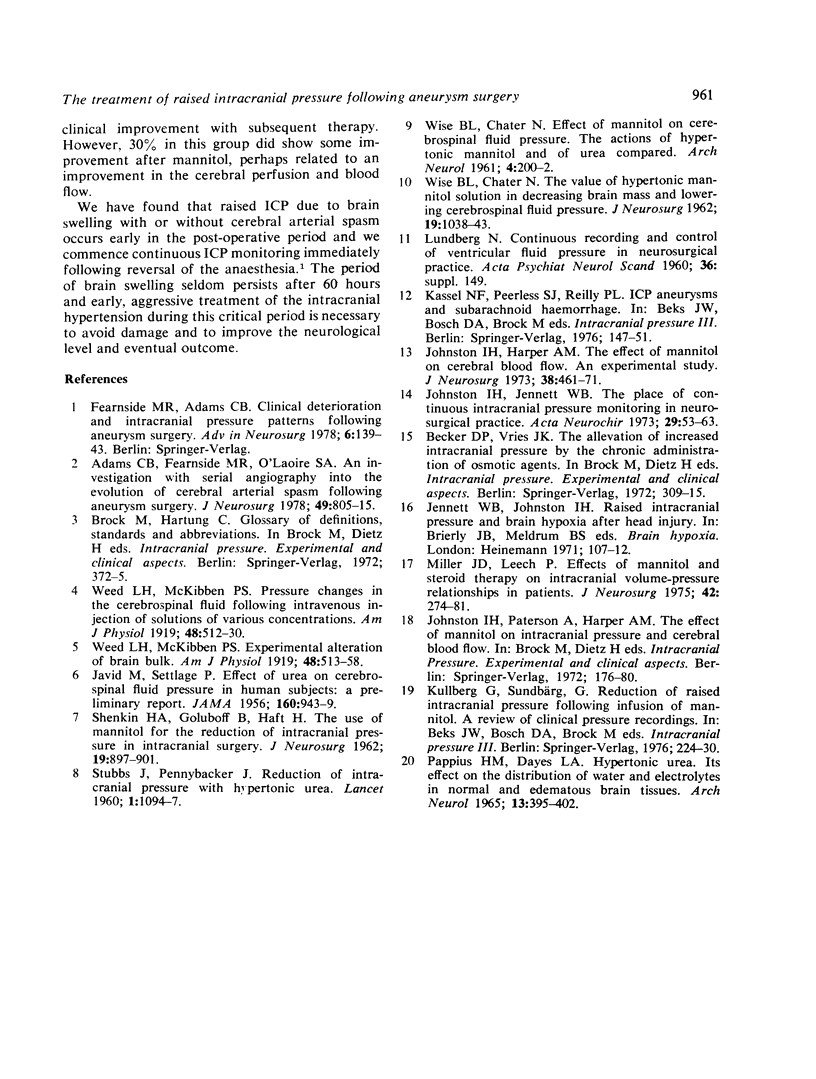Abstract
The effect of intravenous mannitol infusion and withdrawal of cerebrospinal fluid on the intracranial pressure and clinical state was studied in 26 patients with raised intracranial pressure after direct surgery for ruptured aneurysm. Each method decreased the mean intracranial pressure by about 60% of the pre-treatment level. The maximal decrease following mannitol occurred after 60-90 minutes and generally lasted between three and four hours. The effects of mannitol did not decrease when repeated infusions were necessary. Rebound increases in the intracranial pressure following infusion were not observed. Withdrawal of cerebrospinal fluid lowered the intracranial pressure immediately and the effect persisted for approximately 60 minutes. This could be repeated as often as necessary and was without systemic disturbance, although a patent intraventricular catheter was necessary. The two methods could be used simultaneously.
Full text
PDF




Selected References
These references are in PubMed. This may not be the complete list of references from this article.
- Adams C. B., Fearnside M. R., O'Laoire S. A. An investigation with serial angiography into the evolution of cerebral arterial spasm following aneurysm surgery. J Neurosurg. 1978 Dec;49(6):805–815. doi: 10.3171/jns.1978.49.6.0805. [DOI] [PubMed] [Google Scholar]
- JAVID M., SETTLAGE P. Effect of urea on cerebrospinal fluid pressure in human subjects; preliminary report. J Am Med Assoc. 1956 Mar 17;160(11):943–949. doi: 10.1001/jama.1956.02960460021006. [DOI] [PubMed] [Google Scholar]
- Johnston I. H., Harper A. M. The effect of mannitol on cerebral blood flow. An experimental study. J Neurosurg. 1973 Apr;38(4):461–471. doi: 10.3171/jns.1973.38.4.0461. [DOI] [PubMed] [Google Scholar]
- Johnston I. H., Jennett B. The place of continuous intracranial pressure monitoring in neurosurgical practice. Acta Neurochir (Wien) 1973;29(1):53–63. doi: 10.1007/BF01414616. [DOI] [PubMed] [Google Scholar]
- Miller J. D., Leech P. Effects of mannitol and steroid therapy on intracranial volume-pressure relationships in patients. J Neurosurg. 1975 Mar;42(3):274–281. doi: 10.3171/jns.1975.42.3.0274. [DOI] [PubMed] [Google Scholar]
- Pappius H. M., Dayes L. A. Hypertonic urea. Its effect on the distribution of water and electrolytes in normal and edematous brain tissues. Arch Neurol. 1965 Oct;13(4):395–402. doi: 10.1001/archneur.1965.00470040061010. [DOI] [PubMed] [Google Scholar]
- SHENKIN H. A., GOLUBOFF B., HAFT H. The use of mannitol for the reduction of intracranial pressure in intracranial surgery. J Neurosurg. 1962 Oct;19:897–901. doi: 10.3171/jns.1962.19.10.0897. [DOI] [PubMed] [Google Scholar]
- STUBBS J., PENNYBACKER J. Reduction of intracranial pressure with hypertonic urea. Lancet. 1960 May 21;1(7134):1094–1097. doi: 10.1016/s0140-6736(60)90983-1. [DOI] [PubMed] [Google Scholar]
- WISE B. L., CHATER N. Effect of mannitol on cerebrospinal fluid pressure. The actions of hypertonic mannitol solutions and of urea compared. Arch Neurol. 1961 Feb;4:200–202. doi: 10.1001/archneur.1961.00450080082009. [DOI] [PubMed] [Google Scholar]
- WISE B. L., CHATER N. The value of hypertonic mannitol solution in decreasing brain mass and lowering cerebro-spinal-fluid pressure. J Neurosurg. 1962 Dec;19:1038–1043. doi: 10.3171/jns.1962.19.12.1038. [DOI] [PubMed] [Google Scholar]


